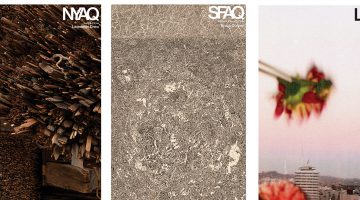Interview by Joey Piziali
So Amanda, SFAQ invited us, Romer Young Gallery (San Francisco), to write a piece for their 13th issue which features Avalanche Magazine and highlights the influence that the magazine and artists of its time have had on contemporary artists of today. They asked us to write about an artist we felt had some kind of connection – be it in theory, practice, or physical execution of work – to conceptual art, performance, film and video from the 1970s. We immediately thought of you. Obviously we are a bit biased because of our relationship with you at the gallery, but knowing your practice as intimately as we do, both Vanessa and I thought you would be perfect.
Avalanche, right? Funny enough I have three original issues on display at my home on a shelf. One even has a pay stub in it belonging to the original subscriber who worked for the City of New York.
How did you come across the issues?
I was a serials librarian at an NYC art university for a stint: official advocate for the art magazines, small books, zines. Sort of a dream job caring for the holdings of seminal journals, going through the boxes of donations from deceased art collectors (strangely lots of nudie photos hidden in between pages), trying to fill gaps in the collection, and cataloguing the odd and forgotten items gathering dust in the basement. Among these ‘basement items’ were a few duplicate issues of Avalanche. The library already had the complete run and a back-up set. So I care-take for those three redundant issues personally, at home.

“Silence, Action, Not Words!”, 2013. Monotype prints, each 15 x 11 inches. A selection of these prints will be on view at ArtMRKT SF 2013.
Care-take? Sounds like a nice way of saying you kind of stole them?! What drew you to the magazine?
I love the mix of messy and tight that this publication represents and the amount of work that went into each issue. This is pre-internet – so most every interview took place in-person and some took place in an altered state, as was characteristic of editor Willoughby Sharp. Liza Béar’s editing becomes all the more impressive in that context. What they end up presenting are active moments and in-flux ideas.
As you go through it, you get an immediate account of a moment in time and a community of people. And the magazine itself functions as a site of production – production of conversations, relationships, artworks-cum-advertisements. I love that the value is located in the exchange between people and people’s agreement to step up into the space of the work. Grassroots activism has a role in this as much as models of conceptual art.

Silence, Action, Not Words! PO1, 2013, fabric dye, discharge and colored pencil on cotton, 40″ x 34″. Courtesy of Romer Young Gallery.
What inspires you about Avalanche sounds a lot like what makes your work great. From your social practice pieces, “Make New Friends” and “Calendar of Events,” to your public collaborative video pieces, “Last Words” or “Callback” readings & performances, you’re always thinking about the “site of production” beyond the expected economy of your studio or the gallery. You’ve been known to use the gallery as an annex studio, as a site of production during your exhibitions.
Yes, I’m always trying to use the work to get at different representations of the social. It necessarily shifts between an extroverted and introverted focus. Organizing exhibitions and events complements and complicates what I learn from my studio painting practice. I’ve always thought of your emphasis on the social as a generous, non-bureaucratic access point to your ideas. You even add footnotes to your titles at times. Right, and I try to build the conversation into the space of the work by making works that ask people to come back to the gallery again for an additional level of experience. I’m asking for something from people, but also giving a lot if they’re compelled to step up and take the time to come back.
What are you working on now?
Right now I’m excited about the monoprints I’m making at Kala Art Institute, based on some of the absurdist slogans of 1968 like: “Action, Silence, Not Words!”
Can’t wait to see them!
For more information on Amanda Curreri, visit Romer Young Gallery, San Francisco.
This interview was selected from SFAQ Issue #13.




